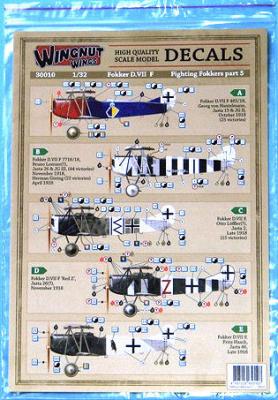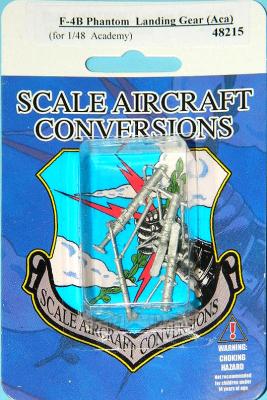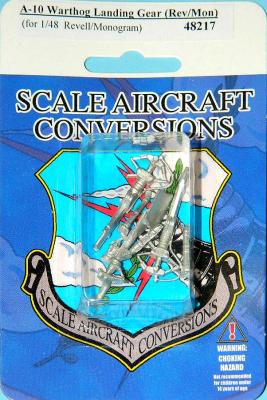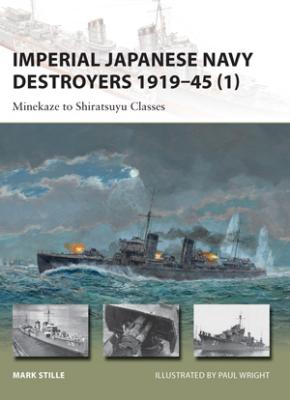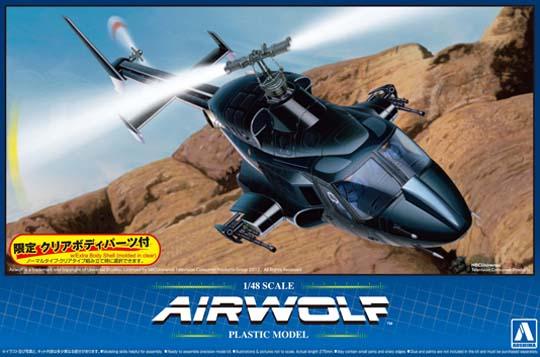Released simultaneously with the Fokker D.VII F kit, this decal set provides five alternative markings for the BMW IIIa-powered version of this famous fighter. It is the fifth in a series of decal sets that Wingnut Wings now offers for the different versions of their Fokker D.VII kits. This set includes two decal sheets, printed by Cartograf. The larger sheet contains the personal markings for each of the aircraft, with codes, national markings, and a variety of panel sections with bands and shapes that wrap around the fuselage. These panels have a number of indents and holes located within them that coincide with the location of openings for control lines, fuel filler ports, etc. The second sheet provides additional sizes of national markings, instrument decals, data plates, propeller markings, and additional stencils.
Welcome to the IPMS/USA Reviews site!
Introduction: The primary organization of the IPMS/USA Review website is by IPMS/USA National Contest Class. Within each Class there are sub-menus by kits, decals, books, etc. The Miscellaneous Class is for items that are not class specific or that cross two or more classes.
IPMS/USA Members: We encourage you to submit reviews, both here and to the Journal. To volunteer for membership in the IPMS/USA "Reviewers Corps" and submit your own reviews, please read the Guidelines For Submitting Product Reviews.
Manufacturers, publishers, and other industry members: IPMS/USA is pleased to offer your company the opportunity for product reviews. All product reviews are performed by IPMS/USA members, and are posted in the publicly-accessible section of our website. With very few exceptions, we perform full build reviews of new kit releases, aftermarket products, and supplies. If you would care to provide product samples for review, please contact John Noack, IPMS/USA 1st VP.
To learn more about IPMS/USA, please see our About Us page.
SAC continues its prolific output of gear to handle the loads on our models. This is yet another drop-fit set designed for an aircraft which can put it to good use, particularly if you load it down with resin aftermarket ordnance (guilty, Your Honor) like an F-4.
Everything was a perfect fit. Main gear legs fit nicely in the resin gear wells (toldja I was guilty). The nose gear slid into place just as easily; the actuating ram also went right into place.
And as usual, my favorite, most-best part…now I don’t have the concern of collapsing gear within a year after I finish the model.
Highly recommended and well done to SAC for yet another winner! Thanks as usual to our friend Russ at SAC for providing IPMS USA this set, and IPMS for sending it to me for review.
Once again, SAC continues its prolific output of gear to handle the loads on our models. This set is perfectly suited for an aircraft like the A-10, particularly with its offset nose gear leg and one-sided wheel yoke. The plastic version will fold or break over time; you may be fortunate enough not to have this happen, but why chance it?
Everything is a perfect fit. Main gear legs and the nose gear are duplicates (with crisp detail and more durable brake hoses – as you can see, the kit parts have a lot of flash on them). Note: This particular A-10 molding dates back to 1987; I first picked up one of these kits at the now-defunct downtown hobby shop in Montgomery, Alabama, while attending Squadron Officer School. That’s how I remember when it came out, as I walked from the base to the shop every Saturday. Yeah, dumb, I put myself at risk, but modeling won out.
Being an avid fan of Imperial Japanese Navy (IJN) destroyers, I was eager to get my hands on this book. The Japanese had two major advantages on the US Navy during the early days of WWII: a superbly trained and equipped air arm and their excellently equipped and crewed destroyer flotillas that made themselves utterly terrifying weapons during engagements like the Battle of the Eastern Solomons. The first chapters of the book provide a good summary of Japanese doctrine and how it developed from the naval treaties and influenced design. The meat of the book specifically addresses the early post-WWI designs leading up to the legendary Fubuki-class destroyers and their successors up to the Shiratsuyu class. Finally, the author provides a summary, defining why these magnificent machines utterly failed to make a lasting impression on the results of the Pacific War.
Introduction
Who doesn’t remember Airwolf? This show is everything good about the 80’s wrapped up into one full hour every weeknight! Highlights from the show include: the spy game, technology, the Communist threat, and, of course, one sleek, futuristic aircraft. Using a Bell 222, the producers of Airwolf designed a supersonic helicopter complete with enough weapons to take down an army, as well as every electronic gizmo. But this review isn’t about the show…so let’s get onto the kit, shall we?
The Kit
At first glance, the kit is a very cleanly cast. Everything is chock full of wonderful detail and very little flash. Included are two versions of the fuselage – clear and black. I will touch on these later, but let’s just say to throw the clear one away, it has no use. Additionally, the kit comes with a stand featuring 3 points of articulation…I loved the stand so much that I have asked Aoshima to release them separately.











